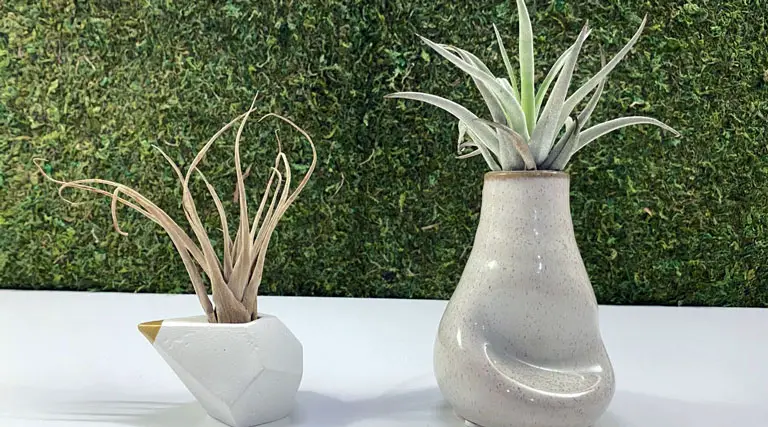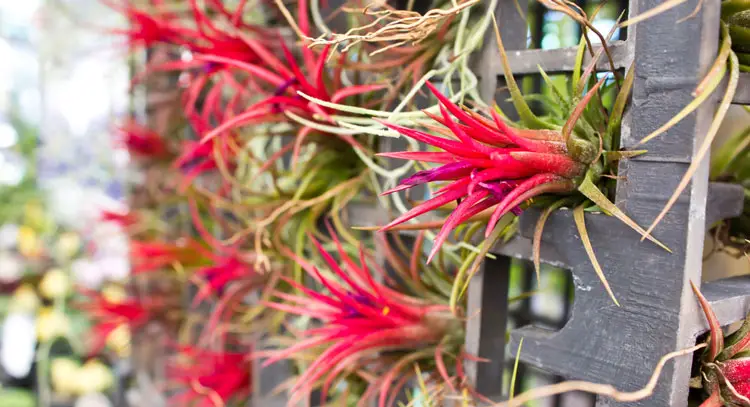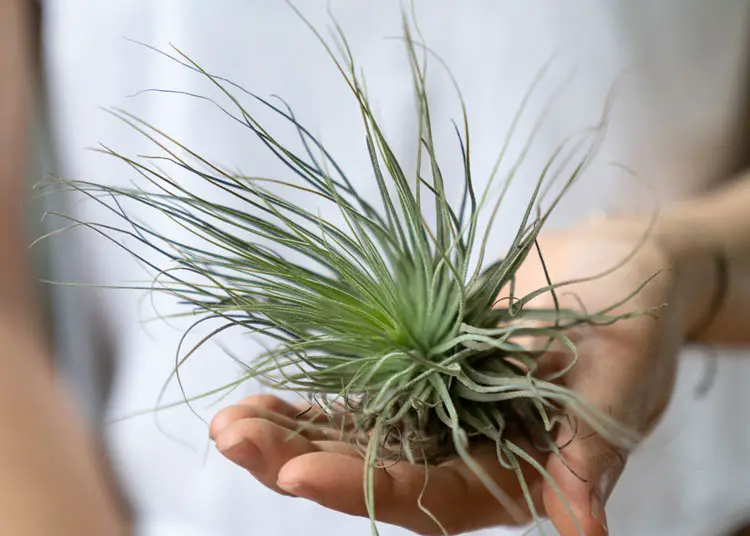How To Tell If Your Air Plant Is Dying? + Ways To Revive

This post follows our research editorial guidelines.

Some plans are dramatic, wilting expressively or shed leaves when stressed. But air plants? They tell you nothing. Also known as Tillandsias, these plants are cryptically quiet, taking all manner of punishment stoically before keeling over. How can you tell if your air plant is dying, or in fact already dead?
Signs of stress in air plants include browning leaf tips and a puckered or wrinkled surfaces. Leaves that have dried to a papery texture or fall off the plant entirely are also signals that your plant is dying or dead. A truly dead Tillandsia will fall apart, often smelling of rot as it does so.

Tillandsias evolved to thrive in the harsh arid highlands of Central America. There’s not much that will kill these hardy charmers, but they do have needs that must be met.
Table of Contents
Let’s take a look at how you can tell if your air plant is in trouble, and what you can do about it.
How To Tell If Your Air Plant Is Dying
“Air plants require proper light, air circulation, and water,” advises Barbara H. Smith. “If the plant is not receiving enough water, the leaves will curl or roll, the foliage will turn a dull color, and the tips will turn brown. Good air circulation is also an important factor in successfully growing air plants. This helps the plant dry between watering and will help prevent disease.”
Barbara H. Smith, HGIC Horticulture Extension Agent for Clemson University.
Your Air Plant has Browning Leaf Tips
Brown leaf tips are the first sign your Tillandsia has problems. It demonstrates they are struggling to keep their leaves well nourished.
All plants produce their food through photosythesis, and air plants are no different. Photosynthesis is the process in which plants take oxygen from the air and water from the soil, and using the light of the sun turn it into sugars. These sugars are the building blocks of all plant biology – without it they cannot grow new leaves or sustain the ones they have.
Brown leaf tips demonstrate a breakdown of some part of this equation, usually a lack of water. It shows that the plant is sucking what resources are already in the leaf in order to make that food. It’s cannibalizing itself to stay alive.

Your Air Plant Has Puckered or Wrinkled Leaves
Tillandsias have specialist tissue deep in their leaves that they use almost like canteen bottles to hold water. When these cells are full, the leaf will be plum and juicy, with smooth surfaces. But if there’s no water, the leaf shrivels.
This is most noticeable at the base of the air plant, especially if you have a bulbous based species like the Tillandsia caput medusae or the popular Tillandsia ionantha.
Your Air Plant Has Shed Leaves
Your Tillandsia’s leaves may create energy, but they use it, too. In times of scarcity or disease it has some decisions to make. It must marshal its resources in a way that allows its most productive leaves to survive. Often, this means sacrificing the oldest leaves.
Air plants will lose their outer leaves as they struggle to keep themselves alive. If you start to see papery, dried up foliage at the outer layers of your air plant, you’ve got some real problems.
Your Air Plant Has Changed Color
Air plants range in color from bright blue greens right through to silvery white. Others have bright peach or golden tips, and many become flush rich scarlet as they prepare to flower.
But by and large their color should remain consistent. Color that fades to yellow or gray-brown in blotches are a sign of problems, usually too little light.
Changes in color that are darker and accompanied with foul smells are a sign of rot. It may be that your Tillandsia is over-watered, or perhaps was damaged and has developed a secondary infection.
It’s also possible it has already died of other causes, and is simply decomposing as all dead things do.
Your Air Plant Smells Bad
Bad smells wafting off your air plant are a sign the end is near. Eggy or effluvial smells are the result of rot deep within the Tillandsia. The ailing plant has been invaded by pathogens, usually fungi or bacteria.
Take a good look for soft spots, oozing areas or patches of discoloration that disintegrate to slime when poked. This is a plant that is decomposing, and it’ll take a lot of work to bring them back – if they aren’t totally dead already.
Your Air Plant Has Flowered
It’s also possible for your air plant to die at the peak of its health, with no other sign of stress or struggle. Air plants flower only once, and once the bloom appears there’s no saving it. Depending on the species, the flower may last a few weeks to a few months before fading. Soon after, the Tillandsia will wither and die.

What Does A Dehydrated Air Plant Look Like?
It can be hard to spot a dehydrated air plant. They’re true survivors, and can endure a lot of neglect.
The first sign an air plant is dehydrated is in the leaves. They will become thinner and flatter, with more curl at the tip than usual. As they continue to dry out the tips of the leaves will turn brown, starting with the older outer leaves.
If you don’t spot these subtle signs, the Tillandsia will continue to dry out until it develops characteristic wrinkles at the base. Thicker parts of the larger leaves may wrinkle or pucker too.
If not treated, the outer leaves will dry out entirely and become papery. Depending on the species the youngest, most fragile leaves may also turn brown and dry out. These desiccated leaves will soon drop from the Tillandsia entirely.
What Does An Over Watered Air Plant Look Like?
In most indoor plants, over-watering leads to root rot. But what does that mean for a plant with no roots? How do you over-water an air plant?
Air plants are a type of bromeliad. Their leaves grow in a rosette, giving them many little nooks and crannies in which to trap water. For most bromeliads, water trapped between leaves is no big deal, but for air plants it’s a different story. Their fluffy, fuzzy layer makes it difficult for that water to evaporate, and it soon becomes stagnant. Fungi and mold move in, rotting the Tillandsia away from the inside out.
Most air plants only need to be watered once or twice a week. They also need to be dried thoroughly afterwards to prevent decay setting in. If your plant is always damp, or is misted or soaked every day, it’s likely you’re over-watering it and increasing the risk of rot.

Can You Save Rotting Air Plant?
Unfortunately, if you want to save an air plant with rot you’ve got a fight on your hands. By the time rot sets in they’ve already been dying for a long time – if they aren’t already entirely dead.
Start by assessing the damage. Soft, rotting leaves is one thing, but a rotten base is another. If the whole thing disintegrates like a moldy onion when pressed you’re probably best to just bid your Tillandsia a fond farewell and move on.
But if there’s more firm base than soft, check for living growth at the heart of the plant. If the newest, youngest leaves are still firm and green, you have a chance.
Remove any dead or rotting leaves with a clean pair of scissors or shears. Rinse thoroughly in clean, lukewarm water and dust any wounds with cinnamon powder. Cinnamon bark is surprisingly strong anti-fungal and antibacterial agent. It’ll help prevent your air plant from rotting further, and help it start to recover.
Avoid copper based fungicides – Tillandsias are very chemically sensitive and copper fungicides have been known to kill them.
Finally, let the Tillandsia dry entirely and place it in a well ventilated, well lit area. Avoid direct sunlight as it heals. Allow it at least a week before you water again, and be very sure it’s dry before you replace it in its home. I’d also suggest you re-apply the cinnamon after watering until you are confident the Tillandsia is on the mend.

How To Revive A Dying Air Plant
First, you need to make sure the air plant is dying, not dead. A totally dead Tillandsia can’t be brought back.
Check for new leaves hidden away at the crown of the plant, and make sure that there’s at least a little firmness to the remaining leaves. Too much soft or rotted tissue, a total absence of healthy leaves, and an overall foul aroma tell you it’s time for a funeral, not intensive care.
But if you have enough plant to revive, re-hydrate as needed and treat any rot. Remove dead leaves and dust with cinnamon, and be sure to place the recovering Tillandsia in a warm, well lit spot.
You’ll have the best chance of success with badly dehydrated Tillandsias, so if your poor air plant is a papery mess of dried out leaves, it’s worth a try. They’ll do well with an overnight soak in a bowl of clean, fresh water. Once you’ve extracted and dried them, cut away any leaves that are still papery to make room for new growth.
Tillandsias are surprisingly hardy, and with patience can spring back from an astonishing amount of neglect. Keep them watered and well lit, and in no time at all they’ll be back to the charming, spiky selves.
